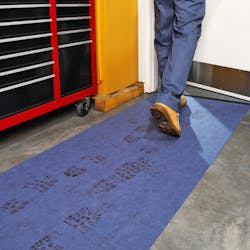Floor safety
Slips, trips and falls are the number two cause of injuries in the U.S., accounting for 40 percent of workers’ compensation and liability claims at a cost of $70 billion per year, says Daniel Silver, vice president of product development for New Pig, and notes that most incidents are the result of unsafe floors.
“Having a dedicated floor safety program is not just a good idea,” he stresses, “it’s a must if you are committed to keeping your employees or anyone visiting your facility safe.”
New Pig (www.newpig.com) specializes in products, services and technical expertise for workplace safety and spill containment.
Many things can cause a floor to be unsafe, he says. For example, when a shop is in an area where rain, snow or ice occur, “you’re going to get water on your floors at the entrances, followed by shoes tracking moisture throughout your facility. The same is true of dirt, dust, salt and mud. Dirty shoes deposit particles on your floor and reduce your floor’s coefficient of friction.
“Inside the garage, maintenance areas, fueling depots and loading docks, leaks, drips and spills happen,” he adds. "It’s a fact of life in the world of fleet maintenance. Oil, grease, coolants and fuels are going to reach the floors no matter how hard you try to prevent them from getting there.”
Because slippery floors can lead to slips and falls, it is important to have a plan on how to deal with the inevitable, and execute that plan relentlessly, he advises. Otherwise, shops will need to be ready for injured employees, lost production time, workers’ compensation claims and legal bills.
PLAN ELEMENTS
Silver says the most important elements of a good floor safety plan include:
- Spill kits with absorbents to soak up leaks, drips and spills.
- Proper daily floor cleaning, with degreasers, if necessary, to remove oils and grease.
- Non-slip shoes to help employees keep safe footing.
- A good commercial floor matting program to keep floors dry and safe.
Manufacturers of commercial floor mats say they eliminate up to 85 percent of tracked-in dirt and water to reduce floor cleaning costs and prevent slips and falls, observes New Pig’s Silver. The most common types of commercial floor mats are the carpeted-top, rubber-backed mats that are either delivered weekly by a local laundering service or bought and owned by a shop.
While floor mats can play a key role in a slip and fall prevention strategy, they can be a potential hazard if these mats are not placed in the proper location or are not regularly maintained. Two particularly suitable locations for commercial floor mats are entrance ways and areas where there is a high probability of contaminants, such as dirt, moisture and grease.
“No matter what you use, keep floors clean and dry, and stay safe,” Silver says.
